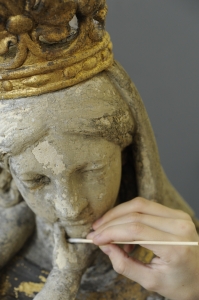The
diploma programme of Conservation and Restoration prepares students for an academic conservator’s field of activity. The five-year
programme offers four specialist areas: paintings, textile, object and stone.
More
information on the programme here.Admission to the Diploma Programme 2023
The
dates for the admission test for the Institute for Conservation and Restoration have been set:
Wed,
11.01.2023 12:00 - Fri, 27.01.2023 12:00 at noon:
Binding online registration and submission of the folder/portfolio
online
Portfolio delivery at the institute during this period additionally possible
Mon,
03.02.2023
Notification of admission to the examination
Fri, 03.02.2023 – Fri, 24.02.2023
Applicants
who have not been admitted to the examination in presence can pick up their portfolio at the institute.
Mo,
27. and Tu, 28.02.2023:
Entrance exam in presence (at the institute Salzgries 14)
Admission
requirements
The future conservators-restorer should possess artistic aptitude and enjoy
practical-manual, craft-based work, but also show an interest in the humanities (art and cultural history, archaeology …)
and natural sciences (biology, chemistry, physics) and provide overview, basic knowledge in these fields. Further computer
knowledge (Microsoft Office programmes, Adobe Photoshop) is desirable.
All those interested should
gather information about a conservator-restorer‘s everyday work beforehand. We recommend undertaking a pre-study internship
of several weeks at a conservation-restoration studio.
The completed 17th year of age is required.
A higher school-leaving certificate is not a legal requirement, but Matura certificate (or equivalent) has proven to be a
good foundation for our study programme.
Sufficient German language skills (both spoken and written)
are a necessity from the start. Also, basic knowledge of English is a prerequisite, as some courses are held in English.
We
would like to point out that due to the extent of compulsory practical work and courses with compulsory attendance during
the first semesters of the programme there will be hardly any opportunity for part-time work or the pursuit of a second study.
Registration,
Portfolio & Examination
Admission to the diploma degree programme is based on a two-tier
process. This includes a pre-selection (submitting portfolio) and an exam. Prerequisite for admission to the entrance exam
is the positive assessment of the application portfolio!
a) REGISTRATION & PORTFOLIO SUBMISSION
The
registration and submission of the application portfolio takes place online. In addition, the portfolio can also be brought
in person to the institute on the 4th floor, labeled with the registration number of the online tool and information on the
desired department, during the same time frame.
If you are not admitted to the second part of the admission
procedure, you can pick up your portfolio during the specified period Monday to Friday from 9:00-15:00. After making an appointment
(kons-rest@uni-ak.ac.at), the assistants of the respective department are available for a personal discussion about the portfolio.
The portfolio should be of generous proportions (sheet size A3 to A2) and contain at least 20 current works.
The Institute asks for precise freehand drawings /studies of nature in pencil (e.g. still life, landscape, etc., preferably
a series). Real objects should be used as templates, no photographs.
The second part of the portfolio
can/should contain works in colour (e.g. watercolours, pastels) and may be more freely designed. The portfolio can also include
works related to specialisations of the programme – these can be documented on photos as it is not recommended to bring the
original to the Institute (e.g. copy of painting, sculpture, etc.). The single sheets are to be labelled with dimensions,
name and date.
Also to be submitted online are the curriculum vitae, educational certificates (e.g.
high school diploma, BHS diploma, apprenticeship diploma, etc.) and, if available, proof of internship (e.g. photo documentation,
etc.). These documents should also be enclosed when submitting the portfolio in person.
Further, applicants should
carefully consider which area of specialisation to choose (paintings, objects, textiles, stone). The decision has to be indicated
with the registration.
b) EXAMINATION
Applicants, who are admitted to the examination,
are informed online. The examination lasts two to three days and consists of written, oral and practical partial tests.
Within
the framework of the entrance exam, applicants‘ artistic-creative and manual skills (moulding, object construction, drawing,
and colour mixing), observation, basic knowledge in chemistry (at secondary school level) and art history (antiquity to modernity)
as well as written skills (art-historical description and motivation letter) are tested.
A personal
interview takes place to address the occupational profile and the applicant‘s motivation to train and work in the area of
conservation-restoration.
The following has to be brought to the test:
- passport
photo
- work utensils: paper A2 (drawing cardboard), drawing pad, pensils (from hard to soft), sharpener, eraser,
vessel for water and colour mixing, brush, e.g. fine round brushes (0-4), flat brushes (6-14), watercolours, writing devices,
scissor, glue, two triangles.
Admission announcement
After
the examination the applicants are informed via e-mail, if they are accepted for the diploma degree programme with start in
the following autumn. Following the exam, the portfolios are handed over. Further, it is possible to get personal feedback
on the portfolio and the performance during the exam. At the University of Applied Arts Vienna there is no lottery, waiting
list or reserve system.
Where / How can I get informed?
The
head and assistants of the Institute would be happy to answer any questions in a face to face meeting regarding the study
programme and the entrance exam. We recommend making an appointment prior to the entrance exam for a critical discussion of
the portfolio and to deal with questions regarding the studies.
Applicants are also invited to
the Open House (each year in autumn) of the Institute. This day provides the opportunity to meet students and teachers and
gain insights into the study programme, the workshops and labs and the occupational field.







